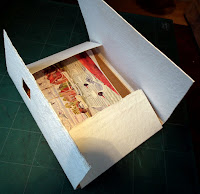For a while now I've been experimenting with instant books using text downloaded from the internet. One of the most instant methods is Japanese binding.
You just download the book you want from Project Gutenberg or wherever, load it into a word processor and format it the way you want. Then you lay it out in double columns and print it on A4 paper.
Each sheet is then folded backwards and assembled into a text block. Add a sheet of decorative paper at either end and sew. Voila!
The beauty of the procedure is that you don't have to use a book production package like Publisher, or faff about with double-sided printing. Just lay it out in two-column format and press the print button.
I must admit I got so lazy I didn't even do the internal supporting twists of paper, just stabbed the text blocks with a thin awl and sewed right in.
The result is rather fetching. And it shows that quite long books can be produced relatively easily, so you aren't limited to slim volumes of contemporary verse.
The next step is to print the text on Falkiner's short grain A4 paper, designed specifically for books, and set the quality to max.
Incidentally, the books are The Wrong Box by R.L. Stevenson and Lloyd Osbourne (l); The Story of Tsing Sung and the Exponent of Dark Magic by Ernest Bramah (c) and Saki's Anti-Christmas, three stories by H.H. Munro (r).












